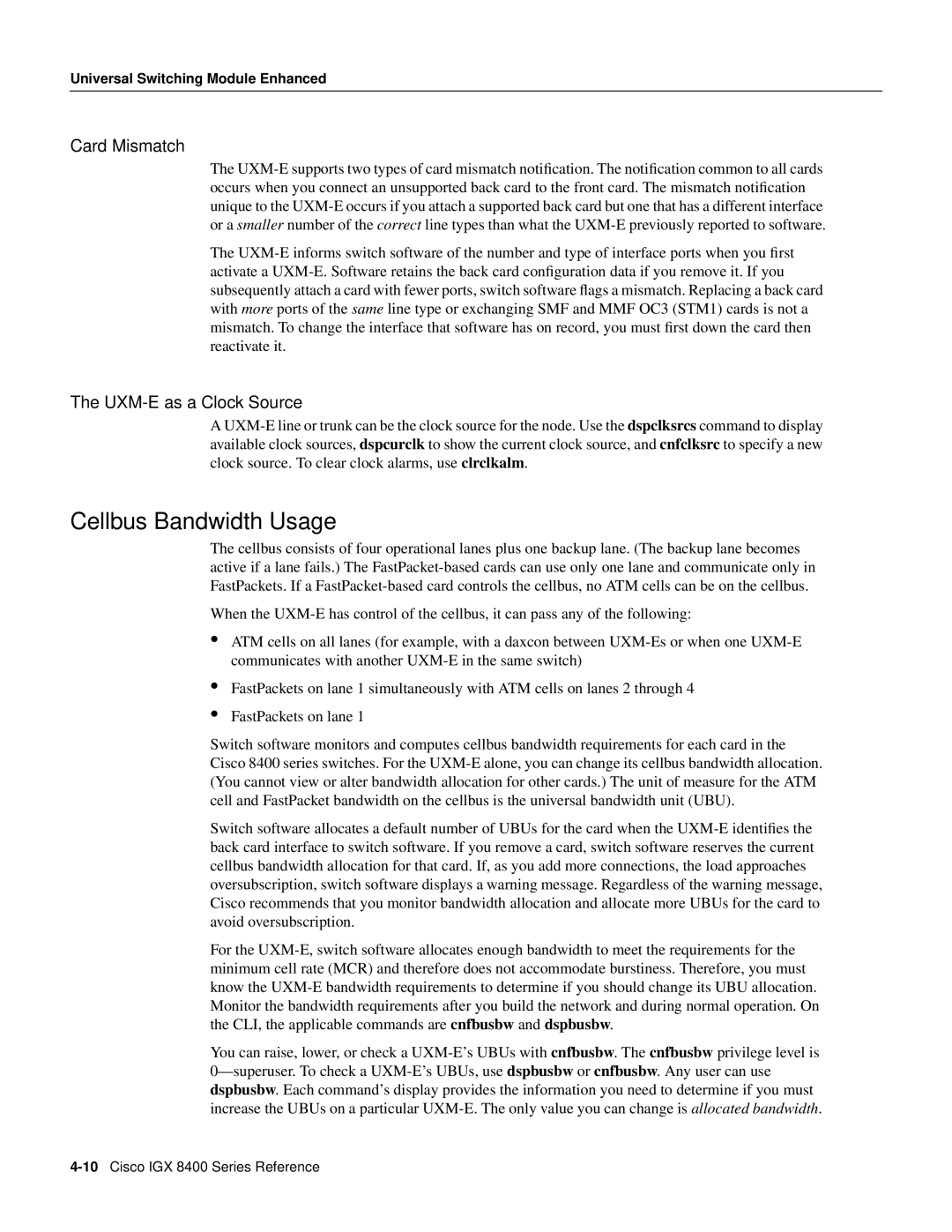
Universal Switching Module Enhanced
Card Mismatch
The UXM-E supports two types of card mismatch notification. The notification common to all cards occurs when you connect an unsupported back card to the front card. The mismatch notification unique to the UXM-E occurs if you attach a supported back card but one that has a different interface or a smaller number of the correct line types than what the UXM-E previously reported to software.
The UXM-E informs switch software of the number and type of interface ports when you first activate a UXM-E. Software retains the back card configuration data if you remove it. If you subsequently attach a card with fewer ports, switch software flags a mismatch. Replacing a back card with more ports of the same line type or exchanging SMF and MMF OC3 (STM1) cards is not a mismatch. To change the interface that software has on record, you must first down the card then reactivate it.
The UXM-E as a Clock Source
A UXM-E line or trunk can be the clock source for the node. Use the dspclksrcs command to display available clock sources, dspcurclk to show the current clock source, and cnfclksrc to specify a new clock source. To clear clock alarms, use clrclkalm.
Cellbus Bandwidth Usage
The cellbus consists of four operational lanes plus one backup lane. (The backup lane becomes active if a lane fails.) The FastPacket-based cards can use only one lane and communicate only in FastPackets. If a FastPacket-based card controls the cellbus, no ATM cells can be on the cellbus.
When the UXM-E has control of the cellbus, it can pass any of the following:
•ATM cells on all lanes (for example, with a daxcon between UXM-Es or when one UXM-E communicates with another UXM-E in the same switch)
FastPackets on lane 1 simultaneously with ATM cells on lanes 2 through 4
FastPackets on lane 1
Switch software monitors and computes cellbus bandwidth requirements for each card in the Cisco 8400 series switches. For the UXM-E alone, you can change its cellbus bandwidth allocation. (You cannot view or alter bandwidth allocation for other cards.) The unit of measure for the ATM cell and FastPacket bandwidth on the cellbus is the universal bandwidth unit (UBU).
Switch software allocates a default number of UBUs for the card when the UXM-E identifies the back card interface to switch software. If you remove a card, switch software reserves the current cellbus bandwidth allocation for that card. If, as you add more connections, the load approaches oversubscription, switch software displays a warning message. Regardless of the warning message, Cisco recommends that you monitor bandwidth allocation and allocate more UBUs for the card to avoid oversubscription.
For the UXM-E, switch software allocates enough bandwidth to meet the requirements for the minimum cell rate (MCR) and therefore does not accommodate burstiness. Therefore, you must know the UXM-E bandwidth requirements to determine if you should change its UBU allocation. Monitor the bandwidth requirements after you build the network and during normal operation. On the CLI, the applicable commands are cnfbusbw and dspbusbw.
You can raise, lower, or check a UXM-E’s UBUs with cnfbusbw. The cnfbusbw privilege level is 0—superuser. To check a UXM-E’s UBUs, use dspbusbw or cnfbusbw. Any user can use dspbusbw. Each command’s display provides the information you need to determine if you must increase the UBUs on a particular UXM-E. The only value you can change is allocated bandwidth.
4-10Cisco IGX 8400 Series Reference
